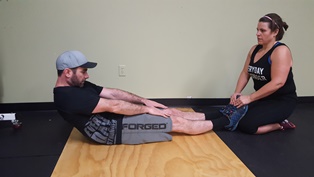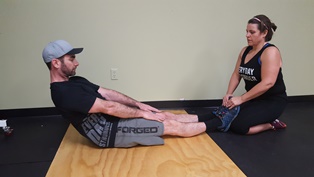SkiErg Technique: Part One
This is the first in a three-part series of cues to help you with SkiErg technique. After having introduced hundreds of athletes to the SkiErg, I’ve noticed three very common faults that appear in new adopters. I’ve developed these memorable cues to help them work through those technique flaws. Furthermore, these are the same cues that I use to take an experienced athlete to a higher level of performance. By learning and understanding these cues, you will hopefully gain a better grasp on the mechanics and flow used in good SkiErg technique.
Part One: Crunch, Don't Bow
After an initial explanation of the fundamentals of technique and a short demo, I have my students hop on and pull, to see what they have gleaned so far. Very often students will take the "core-to-extremity" concept I impart during our instruction (using stronger core muscles firstly and smaller extremity muscles lastly) and implement a very distinct bowing motion, maintaining perfect spinal posture and executing a very solid hip-hinge, like a bow at a performance's curtain call. While I am always very pleased that my students have taken to heart all the information I’ve given them about good deadlift technique (I am a CrossFit Trainer, after all), I have them step away from the SkiErg and go through the following drill:

First sit-up drill
"Lay down on your back on the floor, legs fully extended, and hands on top of your thighs. I am going to hold your feet in place while you attempt two sit-ups. With the first one I want you to initiate your shoulder movement with a distinct crunch, where you are first using your abs to pull your shoulders up off the ground, pressing your lumbar into the floor and curling into the seated position." (This always goes well and everyone seems to understand the concept of a "crunch.")

"For the second sit-up, I want you to maintain perfect posture through your spine and you should only hinge at the hip, as if you are doing a horizontal bow." (This is typically met with moans, groans and often failure.)
After that kinesthetic learning drill, we get back on our feet and discuss the difference between a deadlift and the SkiErg. When we pick something up (or squat or lunge, for that matter) we consciously brace our core in order to maintain a neutral spinal position. It's the same concept when we row: we use good posture to ensure minimal spinal flexion and thus maximal energy transfer from the working parts of our body (primarily hamstrings, quads and glutes) to the place where our energy is actually used (at the end of the oar, the barbell, or that heavy box in the garage.) The SkiErg and the double poling motion of Nordic skiing are both movements that exert force in the opposite direction as the deadlift, squat, lunge or row. Therefore, we must learn to surrender the perfect spinal position in order to better leverage the power we have on the front of our body and its ability to flex, versus maintain extension. The drill on the floor teaches us that when we surrender that posterior extension we are in a better mechanical position to be able to use the abdominal muscles and the hip flexors together (the crunching sit-up), versus the hip flexors only (the straight-back sit-up).
With that drill fresh in their minds, I have my students do some "abs-only skiing" where they focus on flexion and extension of the spine rather than the bowing they were doing previously. I challenge them to work through a very short range of motion with no arm-pull and minimal leg flexion to see how much energy they can produce using only their core. Watching the Performance Monitor during this drill, you can see what type of pace is possible using that short, but incredibly powerful, crunching motion. The fact that I can hold my split time under 2:00 indicates that the crunch of each poling stroke is a critical part to a powerful pulling motion. Our core muscles are much better than our extremity muscles when it comes to sustained energy output, as they can maintain powerful contractions for longer periods of time with less fatigue. So whether we're going short and hard, long and slow, or somewhere in between, crunching rather than bowing is the ticket to success.
